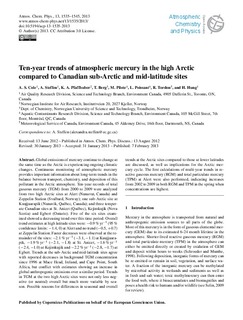| dc.description.abstract | Global emissions of mercury continue to change at the same time as the Arctic is experiencing ongoing climatic changes. Continuous monitoring of atmospheric mercury provides important information about long-term trends in the balance between transport, chemistry, and deposition of this pollutant in the Arctic atmosphere. Ten-year records of total gaseous mercury (TGM) from 2000 to 2009 were analyzed from two high Arctic sites at Alert (Nunavut, Canada) and Zeppelin Station (Svalbard, Norway); one sub-Arctic site at Kuujjuarapik (Nunavik, Québec, Canada); and three temperate Canadian sites at St. Anicet (Québec), Kejimkujik (Nova Scotia) and Egbert (Ontario). Five of the six sites examined showed a decreasing trend over this time period. Overall trend estimates at high latitude sites were: −0.9% yr−1 (95% confidence limits: −1.4, 0) at Alert and no trend (−0.5, +0.7) at Zeppelin Station. Faster decreases were observed at the remainder of the sites: −2.1% yr−1 (−3.1, −1.1) at Kuujjuarapik, −1.9% yr−1 (−2.1, −1.8) at St. Anicet, −1.6% yr−1 (−2.4, −1.0) at Kejimkujik and −2.2% yr−1 (−2.8, −1.7) at Egbert. Trends at the sub-Arctic and mid-latitude sites agree with reported decreases in background TGM concentration since 1996 at Mace Head, Ireland, and Cape Point, South Africa, but conflict with estimates showing an increase in global anthropogenic emissions over a similar period. Trends in TGM at the two high Arctic sites were not only less negative (or neutral) overall but much more variable by season. Possible reasons for differences in seasonal and overall trends at the Arctic sites compared to those at lower latitudes are discussed, as well as implications for the Arctic mercury cycle. The first calculations of multi-year trends in reactive gaseous mercury (RGM) and total particulate mercury (TPM) at Alert were also performed, indicating increases from 2002 to 2009 in both RGM and TPM in the spring when concentrations are highest. | nb_NO |
